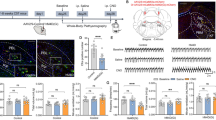Abstract
Receptors for excitatory amino acids in the mammalian central nervous system are classified into three major subtypes1,2, ones which prefer N-methyl-D-aspartate (NMDA), quisqualate (QA), or kainate (KA) as type agonists respectively. These receptors are considered to mediate fast postsynaptic potentials by activating ion channels directly3–5 (ionotropic type6). Recently it was reported that exposure of mammalian brain cells to glutamate (Glu) or its analogues causes enhanced hydrolysis of inositol phospholipids7,8, but it is not clear whether the enhanced hydrolysis is the cause or effect of physiological responses. Membrane depolarization or Ca2+ influx, which can result from Glu receptor activation9,10, can induce enhanced hydrolysis of inositol phospholipids11. We have characterized the functional properties of two types of excitatory amino-acid responses, those activated by QA (or Glu) and those activated by KA, induced in Xenopus oocytes injected with rat-brain messenger RNA12. We report evidence for a new type of Glu receptor, which prefers Q A as agonist, and which directly activates inositol phospholipid metabolism through interaction with GTP-binding regulatory proteins (Gi or Go13,14), leading to the formation of inositol 1,4,5-trisphosphate (InsP3) and mobilization of intracellular Ca2+. This QA/Glu reaction is inhibited by islet-activating protein (IAP, pertussis toxin15), but was not blocked by Joro spider toxin (JSTX)16, a specific blocker of traditional ionotropic QA/Glu receptors.
Similar content being viewed by others
References
Watkins, J. C. & Evans, R. H. A. Rev. Pharmac. Toxicol. 21, 165–204 (1981).
Fagg, G. E. Trends Neurosci. 8, 207–210 (1985).
Nowak, L., Bregestovski, P., Ascher, P., Herbet, A. & Prochiantz, A. Nature 307, 462–465 (1984).
Cull-Candy, S. G. & Ogden, D. C. Proc. R. Soc. B224, 367–373 (1985).
Kiskin, N. I., Krishtal, O. A. & Tsyndrenko, A. Ya. Neurosci. Lett. 63, 225–230 (1986).
Eccles, J. C. & McGeer, P. L. Trends Neurosci. 2, 39–40 (1979).
Sladeczek, F., Pin, J. P., Recasens, M., Bockaert, J. & Weiss, S. Nature 317, 717–719 (1985).
Nicoletti, F. et al. J. Neurochem. 46, 40–46 (1986).
Retz, K. C. & Coyle, J. T. Neuropharmacology 23, 89–94 (1984).
MacDermott, A. B., Mayer, M. L., Westbrook, G. L., Smith, S. J. & Barker, J. L. Nature 321, 519–522 (1986).
Kendall, D. A. & Nahorski, S. R. J. Neurochem. 42, 1388–1394 (1984).
Gundersen, C. B., Miledi, R. & Parker, I. Proc. R. Soc. B221, 127–143 (1984).
Sternweis, P. C. & Robishaw, J. D. J. biol. Chem. 259, 13806–13813 (1984).
Neer, E. J., Lok, J. M. & Wolf, L. G. J. biol. Chem. 259, 14222–14229 (1984).
Ui, M. Trends pharmac. Sci. 5, 277–279 (1984).
Abe, T., Kawai, N. & Miwa, A. J. Physiol., Lond. 339, 243–252 (1983).
Hirono, C., Ito, I. & Sugiyama, H. J. Physiol., Lond. 382, 523–535 (1987).
Berridge, M. J. & Irvine, R. F. Nature 312, 315–321 (1984).
Oron, Y., Dascal, N., Nadler, E. & Lupu, M. Nature 313, 141–143 (1985).
Saito, M., Kawai, N., Miwa, A., Pan-Hou, H. & Yoshioka, M. Brain Res. 346, 397–399 (1985).
Sugiyama, H., Hisanaga, Y. & Hirono, C. Brain Res. 338, 346–350 (1985).
Hirono, C. et al. Brain Res. 359, 57–64 (1985).
Author information
Authors and Affiliations
Rights and permissions
About this article
Cite this article
Sugiyama, H., Ito, I. & Hirono, C. A new type of glutamate receptor linked to inositol phospholipid metabolism. Nature 325, 531–533 (1987). https://doi.org/10.1038/325531a0
Received:
Accepted:
Issue Date:
DOI: https://doi.org/10.1038/325531a0
- Springer Nature Limited
This article is cited by
-
DNA Methylation-Dependent Gene Expression Regulation of Glutamate Transporters in Cultured Radial Glial Cells
Molecular Neurobiology (2022)
-
Hypergravity induced disruption of cerebellar motor coordination
Scientific Reports (2020)
-
Activation of group I metabotropic glutamate receptors regulates the excitability of rat retinal ganglion cells by suppressing Kir and I h
Brain Structure and Function (2017)
-
Control of neuronal excitability by Group I metabotropic glutamate receptors
Biophysical Reviews (2017)
-
mGluR5: Exploration of Orthosteric and Allosteric Ligand Binding Pockets and Their Applications to Drug Discovery
Neurochemical Research (2014)





